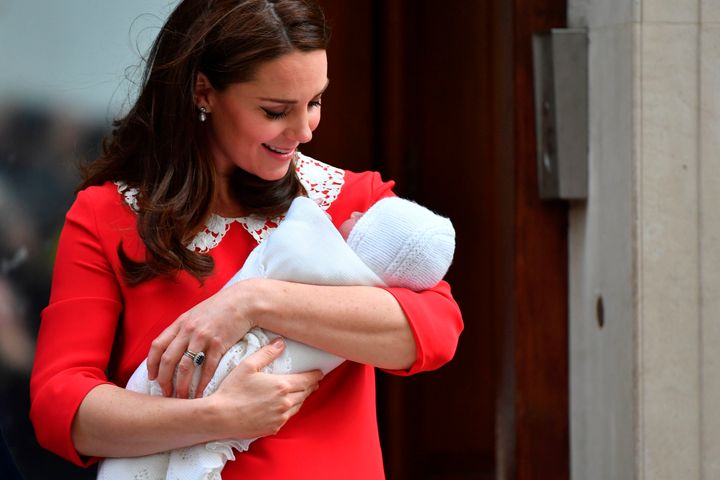
When I realized I’d be having a baby around the same time as a princess, a supermodel, a Jenner and a Kardashian, I made some threats about quitting social media. Otherwise, I figured, I’d be spending my maternity leave torturing myself, scrolling through pictures of hot celeb moms who are able to do the impossible just days after giving birth, like zip up pants.
LOLOL.
I couldn’t really give up staring at strangers and famous people while breastfeeding my son throughout the day and night. So, for about two months, I settled into my nursing chair, wearing a steady uniform of maternity pants (read: no zippers, no buttons), paired with men’s Hanes T-shirts drenched in breast milk. From my phone, I watched the parade of A-listers drop their baby announcements and flawless postpartum bodies. There was Kylie Jenner sporting a crop top and a thong a month after having Stormi. And the Duchess of Cambridge, formerly Kate Middleton, looking ready for a gala to save elephants just seven hours after she had Louis.

Famous people make having a baby look as delightful as picking up a new puppy. Just go in, take care of some things and out you go, looking put together, #blessed and over the moon about your family’s new addition. (“And just like that, we’re a family of three! heart, baby bottle, prayer sign emojis”)
But then came Chrissy Teigen. She birthed Miles Theodore and a couple of tweets that stunned the internet last month. But not because she looked stunning. Rather, it was because she broke protocol and shared graphic ― and accurate ― details about what happens during and after labor.
In one tweet, Teigen acknowledged that she had a tougher delivery with her daughter, Luna. “I can confirm postpartum life is 90 percent better when you don’t rip to your butthole,” she wrote.
Unsurprisingly, there’s little talk from celebs, and regular people, on the internet about how a vaginal birth can tear up your body. Turns out, there are four degrees of vaginal tears, or perineal lacerations ― with the first degree being the least severe and the fourth being the most. Teigen likely had a third or fourth degree, where the laceration can stretch all the way to the rectum.
I only first heard about these varying degrees of vaginal tears while splayed on a hospital bed. As my obstetrician worked the needle and thread, she casually told me I had a stage two tear. I had done a fair amount of WebMD-ing and probably should’ve known more about the risks involved, but I didn’t.
Part of the issue is that in the U.S., we sanitize what it takes to become a mother. It’s a longstanding tradition here ― like eating hot dogs at a baseball game ― to expect moms to endure this herculean process of growing a baby, expelling it from our bodies, or having it excised, and then act like nothing happened. Nothing to see here. Just some professionally shot Facebook family profile pics. (Mom just happens to also be wearing a 4-inch-thick pad in her undies topped with ice packs and numbing cream. She might’ve taken breaks between shots to make sure she wasn’t having a postpartum hemorrhage.)
Quick reminder: We’re the only developed country that doesn’t have mandated paid maternity leave. Some women are even going back to work within hours of bringing a human being into the world. You’d probably have an easier time getting off for breaking a toe.
It’s no surprise then that we celebrate bodies that squeeze into tight jeans after squeezing out a baby. But we don’t acknowledge the more superhuman part of the birthing effort. You know, the part that requires grit and strength, and is bloody and terrifying, even when things go right.
It may seem trivial, but it matters. Think about your annoying friends on Facebook who run races and post nonstop updates about their training and events. They don’t put on makeup and eyelash extensions after completing 26.2 miles. They post sweaty-ass photos of themselves proudly holding their 205th place medal. They share intimate details about ripped toenails and using foul-smelling port-a-potties during marathons.
This is how you get through something that’s taxing on your body and spirit. You collect high-fives and commiserate about the most grueling challenges.
I had my own “Chrissy Teigen butthole” moments when I gave birth both times. I wish I had known more about them in advance and could’ve talked more about them after.
For example, after laboring for 12 hours with my older son, I had an emergency C-section. While I heard the doctors discussing my bladder and other organs as they nimbly made their way to my uterus, I averted my eyes to the ceiling. As I stared up at the light fixture, I saw my insides reflected back at me.
About 20 hours into my second delivery, when I was fully dilated, my epidural wore off. (This is a thing). My anesthesiologist was busy with another emergency, and that was that. This was a shame because my birth plan consisted of one step: drugs and a lot of them.
It felt like a lawnmower had been unleashed onto my insides and was repeatedly running over every organ just to make sure they were perfectly flattened. There’s also a good chance I fractured my tailbone during the pushing process.
The room was packed with about 15 young medical professionals who had about 300 years of education between them. So when they all started chanting my name and cheering me on, I felt like, “Oh, hell yeah, I can do this.” I imagined this must be what an underdog winning quarterback feels like.

In the days and weeks after I had both boys, I wanted to be like that old guy who sits on the couch recalling his glory days in sports. Turns out, that’s not what most people really want to talk about.
After reading Teigen’s tweet about her aching tush and another about her love for roomy mesh hospital underwear, I felt hopeful that the conversation could start to shift.
When I watched comedian Ali Wong’s Netflix special, “Hard Knock Wife,” in which she offers up grisly childbirth jokes, I thought, “OK, we’re finally doing this!” (For example: She talks about all the “crazy shit” that comes out after the baby’s born. ”You know what else exits? Her house. Her living room, her pillows, the Bob Marley poster, all the food that went bad in her refrigerator for months.”)
I felt the same way when I binge-watched Netflix’s new series “The Letdown,” a show that centers on a chronically sleep-deprived mom, played by Alison Bell, who has perpetually unwashed hair and bras and finds unexpected support in a new moms’ group. In the first episode, each woman shares her own labor (war) story, which touches on forceps, fourth-degree tears, anal fissures, C-sections and life-threatening situations.
If women as pretty and smart and influential as Teigen, Wong and Bell can speak openly and unashamedly about the gruesome realities of childbirth, then maybe more moms will start to. So, at the very least, we can begin to give props to the average postpartum body that may be stretched, tired, leaking and banged up, and isn’t very average at all.
